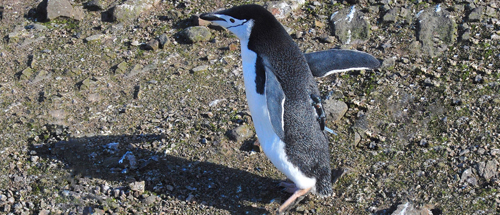← Back
Chinstrap penguins are spreading a long way around Antarctica

Chinstrap penguins live around Antarctica. To understand better the precise reasons why their population is slowly declining, researchers from the Antarctic Ecosystem Research Division of NOAA fitted some of them from three different breeding grounds with Argos PTT, to track them during the Austral Winter, comparing the tracks with environmental data.
Chinstrap penguins (Pygoscelis antarctica) are encountered around Antarctica, mainly in the sector corresponding to the Atlantic Ocean. This species is not among the most threatened penguins, but the adult population is declining in the region of the Antarctic Peninsula. Their breeding sites on isolated islands are known, but their distribution in the ocean during the rest of the year, especially in winter, is less so, even though environmental conditions during winter are suspected contributors to their decline.

Location of the three chinstrap penguin colonies (at the tip of the Antarctic Peninsula) (Credit NOAA)
Forty-one adult and juvenile chinstrap penguins were tracked using Argos telemetry during the austral winter of 2017. They were fitted with the Argos PTTs at three different breeding locations with contrasting population trends in the northern Antarctic Peninsula region. One of the hypotheses to be tested is that they may disperse differently depending on their colony of origin.
The tracks thus obtained were compared with environmental parameters the penguins encounter: sea ice (including sea ice edge since the chinstrap penguins are generally avoiding ice), sea surface temperature and surface currents (indicators of the oceanic fronts where the foraging grounds are found for a number of species in the area), and bathymetry.
More info about birds tracking

Month-by-month chinstrap penguin tracks (the colors of the line refer to the colonies of origin) vs sea ice concentration (grey scale close to the continent) and sea surface temperature (colored scale over ice-free waters). The black lines are showing the different current fronts. The penguins are moving between the ice edge and the polar front (thick solid black line) (Credit NOAA)
Birds from the colony with an increasing population tended to stay closer to their colony during winter, which may be a clue that local conditions are important during the overwinter period, but it remains uncertain why some individuals bypass favorable local conditions and migrate into remote areas of the Southern Ocean. Some generic behaviors were observed, such as staying between the ice edge and the Polar front, and using ice-free deep water at temperatures less than 2°C. The colony of origin seems to drive some behaviors at a very broad level, such as some individuals going east or none at all. Results also show that the path of each penguin is mostly unique, including their chosen stopovers, which scarcely overlap. The chinstrap penguins do not seem to have colony-driven paths to given wintering grounds. This probably means that this species take profit in their environment wherever and whenever they can, without preference for specific locations.
Reference
- Hinke JT, Santos MM, Korczak-Abshire M, Milinevsky G, Watters GM (2019): Individual variation in migratory movements of chinstrap penguins leads to widespread occupancy of icefree winter habitats over the continental shelf and deep ocean basins of the Southern Ocean. PLoS ONE 14(12): e0226207. https://doi.org/10.1371/journal.pone.0226207
Photo: A chinstrap penguin (credit NOAA)

